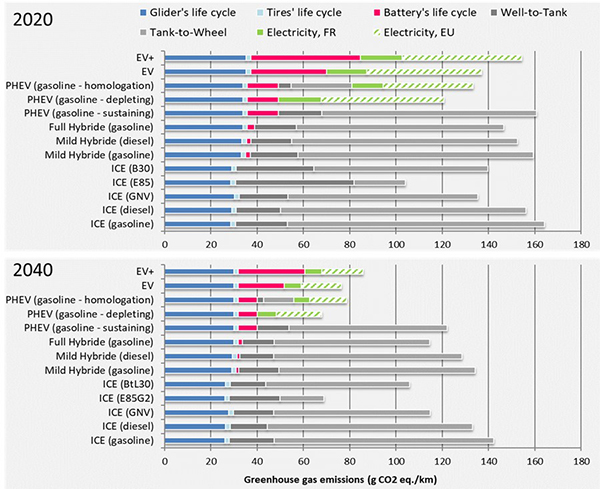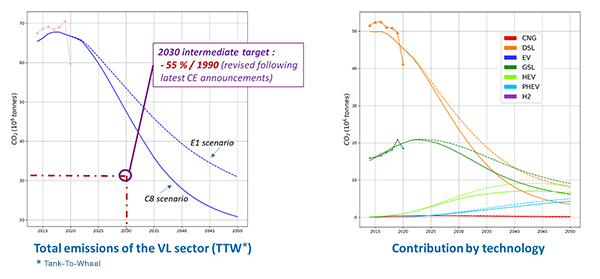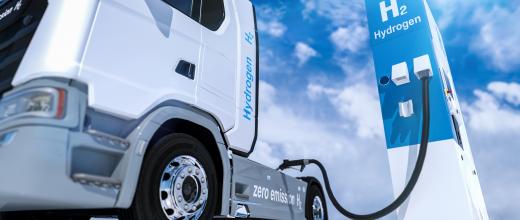Cutting CO2 emissions from road vehicles is essential and necessary to reduce long-term greenhouse gas (GHG) emissions in France. The transport sector is still responsible for more than 30% of national emissions, making it the sector with the highest level of emissions. The development of new low-carbon powertrains may also result in an improvement in air quality and help reduce our reliance on imported fossil fuels.
In order to compare the various technologies available for road transport, both mature and future, IFPEN joined forces with ADEME to conduct the E4T 2040 prospective economic and environmental study of the sector [1]. To do so, it developed methods and tools making it possible to conduct the analyses required following a multi-scale approach.
These analyses were initially conducted on a vehicle scale, studying a multitude of segments, ranging from urban cars to heavy articulated trucks, as a function of several operating conditions combining urban and extra-urban journeys. Starting from hypotheses relating to the evolution of propulsion technologies, the consumption and emission results for each type of vehicle were determined and forecast to the year 2040.
These economic and environmental results were then fed into a discrete choice model1, DRIVERS (DiscRete choIce modeling for low-carbon VEhicles fleet scenaRioS), in order to transpose these analyses to the scale of the global vehicle fleet on the road. The DRIVERS model can be used to produce different road transport demand forecasts, global or by technology type, as a function of several public policy scenarios, and to deduce the associated pollutant emissions.
This methodology, deployed for the E4T 2040 study, was developed by IFPEN within the framework of a dedicated research project. For the environmental part, methodological developments related more particularly to vehicle Life Cycle Analysis (LCA) indicators [2]. As for the new DRIVERS prospective model, its utility function2 incorporates a first component related to the costs of vehicle ownership and a second component related to the behavior of economic agents. This second component was the focus of more fundamental research in behavioral economics [3].
The results obtained using these new approaches show that technical progress combined with the fall in the cost of electric solutions (particularly batteries) will enable them to penetrate the market. The LCA results show that with the French electric mix the shift to battery electric vehicles produces significant benefits in terms of reduce GHG emissions, with emissions associated with battery production tending to reduce between now and 2040 due in part to the relocation of this production to Europe during the timeframe (Figure 1).

Lastly, looking towards 2050, the prospective analysis of the evolution of the French vehicle fleet indicates that, even in the most favorable scenario for the sale of battery electric vehicles, the Green Deal objectives (90% cut in transport sector CO2 emissions by 2050 compared to 1990) are not met (Figure 2). These projections show that, without an increase in the use of biofuels and a fundamental change in mobility behavior via suitable public policy support measures3, the stated decarbonization objective for the transport sector will be difficult to achieve.

1- Type of model widely used in transport economics to determine the probability of users adopting alternatives, drawing on utility functions.
2- Mathematical function aimed at quantitatively translating the utility concept in order to incorporate it in a choice model.
3- Car-sharing, development of public transport and inter-modal transport options, soft mobility, etc.
References:
-
Etude énergétique, économique et environnementale du transport routier à horizon 2040 [Energy, economic and environmental study of the transport sector to the year 2040] (E4T 2040), IFPEN-ADEME, 2022. 126 pages.
>> https://librairie.ademe.fr/mobilite-et-transport/5949-etude-energetique-economique-et-environnementale-du-transport-routier-a-horizon-2040-e4t-2040.html
-
Ternel C., Bouter A., Melgar J., Life cycle assessment of mid-range passenger cars powered by liquid and gaseous biofuels: Comparison with greenhouse gas emissions of electric vehicles and forecast to 2030, Transportation Research Part D, Vol. 97, 2021.
>> https://doi.org/10.1016/j.trd.2021.102897
-
3. Thesis currently being prepared by Alexandre Cambo: Modélisation de la demande de transport routier européen et de ses impacts environnementaux pour les véhicules particuliers à l'horizon 2040 [Modeling of European road transport demand and its environmental impacts for private vehicles to the year 2040].
Scientific Contacts: Benoît Cheze ; xavier.guichet@ifpen.fr ; joris.melgar@ifpen.fr







